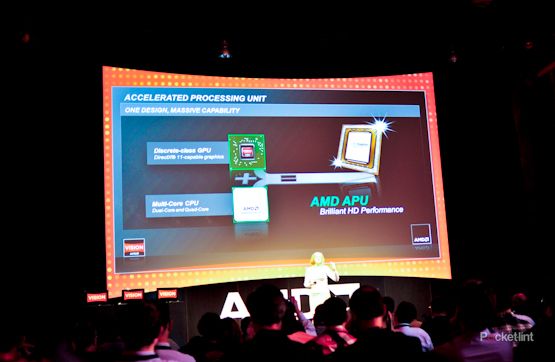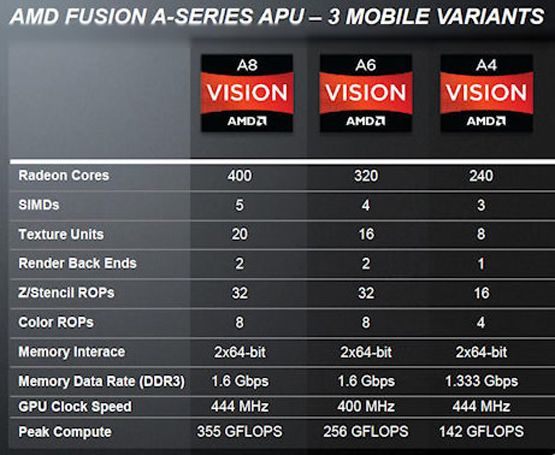Any new PC or laptop purchase means being confronted with devices adorned in shiny stickers. Search closely and you will spot a trend; most have a big Intel logo slapped on them. But there are a rebellious few that are adorned with the words AMD.
The processor underdog has long sat beneath Intel's crown, but now, with AMD Fusion and its clever APUs, it looks like they might just have something to take on the all powerful Sandy Bridge.
To the average shopper however, the decision between Intel and AMD is far from clear, most will opt for a logo they know, safe in the knowledge that if Intel works on a friends PC, it will work on theirs. But breaking from the Intel safe-house is by no means a bad move. AMD have some really great processors on offer with their A-series APUs. The problem is, what exactly do they do differently to Intel?
The Fusion APU explained
Perhaps best to start by explaining what exactly an APU, or Accelerated Processing Unit, is. Ever noticed all those boards and fans inside your computer? Well an APU shrinks most of that down and sticks it on a single chip. This means graphics and the majority of other computing tasks can all be managed from one single place. The result is a whole heap of benefits that make day to day computing much easier. Admittedly both AMD and Intel manufacture APUs, the difference is most associate Intel with the idea of CPUs, so they just didn't adopt the moniker. Both companies' processors make a significant difference to your computing capabilities. With AMD Fusion however there are a few that really stand out as useful.
Power
The first real benefit is laptop battery life. What AMD is calling "All Day" power essentially means 11 hours of idle battery, or about two and a half when the system is under very heavy load. AMD says that they get an extra hour over Intel options when putting laptops to the test. But until we really push a laptop through its paces and draw our own comparisons, we would take some of this with a pinch of salt. The bottom line is, a Fusion APU means longer times between laptop charges.
Vision
Video fans in particular will like this element of AMD's A-series processors. AMD has made things highly video-centric, meaning 1080p high definition playback is always smooth. YouTube video for example can be dealt with on-the-fly by the APU and subsequently smoothed out. Colour correction and one click video fixing is also very well supported by the processors.
AMD has kept its nomenclature as simple as possible with the A-series processors. Doing away with GHz and all the other complexities of techie-speak, things simply go up in steps from an A4 to an A8. The bigger the number, the more computing grunt.
Gaming
Those computers or laptops with numbers high up AMDs A-scale should be more than capable of running the latest games. AMD are well known for their gaming fan club and it looks like they haven't disappointed with their Fusion setup. The A8 in particular is mightily powerful.
At a recent AMD event we got a chance to put a few laptops boasting the top of the line processor through their paces. Particularly impressive was their ability to run demanding games like that of Dirt 3 at full 1080p resolution with no slow down whatsoever. This means those who fancy a bit of gaming, but don't wan't the complexities involved in choosing a powerful gaming rig, should look to the A8 for a simple solution.
That said, opting for an Nvidia and Intel setup, whilst being more complicated and possibly more expensive, will get you the best top of the line gaming experience.
So should I buy one?
We recently spoke to Lesley Sobon, AMD's vice president of product and platform marketing, about exactly what Fusion means for the company, to try and get a better idea if it's worth picking one up.
It looks like AMD is desperate to simplify the computer purchasing experience as much as possible.
"If you wan't basic browsing, HD, you watch video online, here you go, pick an A4," said Sobon.
The problem is, most that pick up a computer for precisely those reasons will find it has an Intel processor already stuck in it.
Ultimately the choice between the two at an affordable consumer level will make relatively little difference. It's the things you won't initially notice that might be enough to sway you in AMDs direction. Perhaps one day you'll get that extra hour of battery and be glad you chose a Fusion setup. You might even be editing video or watching a movie and notice things look extra nice.
In the end, though, the decision is up to you. Personally what we think should sway it is what else the laptop has to offer. In a computer market, where just about everything has more than enough power for day to day tasks, it should be things like size, colour and build quality that force that final decision.
Simple question..AMD or Intel? Comments below..



